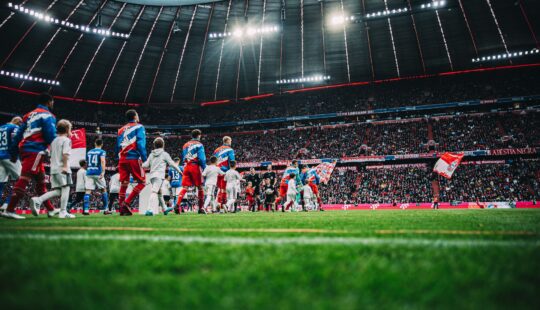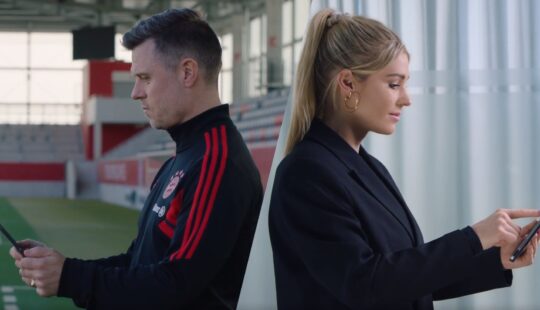After intensive preparation, 24 European national soccer teams will be presenting themselves at the upcoming European Championship. Besides concentrating on training and match practice, they’ll be analyzing their opponents and discussing tactics and game plans. Germany’s coaching team is relying on technology-driven support from the sports management solution SAP Sports One.
Sights Set on the European Championship
“SAP Sports One enables us to efficiently share tactical insights and key information about our next opponents with our players. And by accessing the software on a tablet, we can even give them the latest updates in the changing room shortly before kickoff or at half time,” says Benjamin Glück, assistant coach to the German national A-team.
“SAP’s sports management suite is very important to the national soccer team as a central platform for collecting and analyzing data and for presenting the insights gained from that data to our players,” explains Glück. “We use the video and visualization functions in SAP Sports One to help us illustrate findings about our opponents and their key players. These features make conveying tactics and preparing for specific matches much easier and clearer.” The German team also uses analytical insights to prepare for penalty scenarios. In SAP Penalty Insights, goalkeepers can study the behavior of potential penalty-takers, such as which area of the goal they usually aim for and even how these preferences change under pressure. Conversely, penalty-takers can gain insights into the tactics of their opponents’ goalkeepers.
The coaches and analysts of the German Football Association (Deutscher Fußball-Bund, or DFB) work with data created within SAP Sports One as well as data and analyses from third-party sources. The SAP solution serves as the central platform for consolidating and analyzing all the data.
An SAP App for All Players
Germany’s national players stay in close contact with their coaches and analysts through the SAP Sports One messaging app – SAP Team One – which they have on their phones. Among other things, the mobile app is used to pass on match preparation information, such as opponent analyses, annotated clips, and videos.
The players also use the mobile app to share information about themselves. For example, they complete questionnaires about how intense they perceived the last training session or match, how well they slept, and how they are feeling overall. Their responses are used to generate an RPE (rating of perceived exertion) value. By gauging each player’s general health and well-being in this way, coaches can manage intensity levels according to each individual’s situation. Both the DFB and the player’s home club monitor this RPE value to guard against overtraining and injury. SAP Analytics Cloud can draw on data from SAP Sports One to create player-specific reports that are forwarded to the player’s home club after courses, tournaments, and matches the German team takes part in.
DFB and SAP: An Established Partnership
The DFB is a familiar name around the globe. With almost 7 million members spread across more than 25,000 clubs, it is the world’s largest national sports federation. At the World Cup in Brazil in 2014, which Germany won, the country’s national team was already using SAP Match Insights, a prototype of the solution that is now part of SAP Sports One. This prototype helped the DFB evaluate large volumes of data for match analysis for the first time.
Today, more than 1,000 DFB users – players and the “teams behind the teams” – work with SAP Sports One. “Our successful collaboration with the German national team was a key factor in SAP’s decision to turn the prototype we developed for the DFB into a standard product. Now, clubs and associations in 19 countries are using SAP Sports One,” says Fadi Naoum, senior vice president and head of Development, SAP Sports One. More joint projects followed, including the development of SAP Penalty Insights and SAP Challenger Insights, a mobile app that helps teams prepare for upcoming matches. On the horizon of this co-innovation partnership are plans to leverage the power of AI to make the functions in SAP Sports One even more efficient.
Shaping the Future
In addition to Germany’s national men’s and women’s soccer A-teams, the DFB manages 12 junior and U21 teams, too. “The challenge for us is to keep a close eye on the pool of talented young players we have and to help them reach their full potential,” says Christofer Clemens, the DFB’s head of Scouting, Match Analysis, and Diagnosis. “Our coaching teams watch an average of 1,500 games every season and identify a large number of gifted talents in the process. To qualify these players, the coaching teams compile a huge volume of scouting reports, which we manage in SAP Sports One. These qualitative insights are vital for us. However, at the moment, the task of judging the development of a player or comparing individual players based on that information is time-consuming,” says Clemens. “We’re hoping that AI will make the complex task of analyzing these vast amounts of data much simpler for us.” Alongside scouting reports, the DFB plans to use publicly available data sources and match statistics to complete player profiles.
“Another area where the DFB sees enormous potential for AI is in analyzing opponents before international matches,” says Martin Vogelbein, a member of the DFB’s Scouting, Match Analysis, and Diagnosis team and project lead in managing the SAP Sports One solution. SAP Sports One is already helping the DFB prepare for big games, he explains, but the plan is to go a step further and use AI to automatically analyze insights from opponents’ past matches.
“We are hoping that SAP’s AI copilot, Joule, will bring enormous benefits in terms of consolidating match reports. That would minimize the manual tasks our match analysts need to complete and reduce the time it takes to get answers to a range of key questions we have when preparing for games,” says Vogelbein. Typical questions are: What patterns are visible in the opposing team in different phases of the match? What does this tell us about the team’s strengths, weaknesses, and about the options we have? “We already have a huge amount of information – particularly qualitative data – available to us before games. SAP Challenger Insights, a component of SAP Sports One, allows us to visualize insights from that information and discuss them with the team. But, looking ahead, AI-driven analyses could help us prepare key background information for our players even more easily,” says Vogelbein.
Clemens and Vogelbein are very pleased with the results so far. “We see enormous potential in our work with SAP on the AI-driven evaluation of information that is relevant for scouting and match analysis. The prototypes SAP has presented to the DFB look very promising, and we are looking forward to using them live soon.”
Top image courtesy of Thomas Böcker



